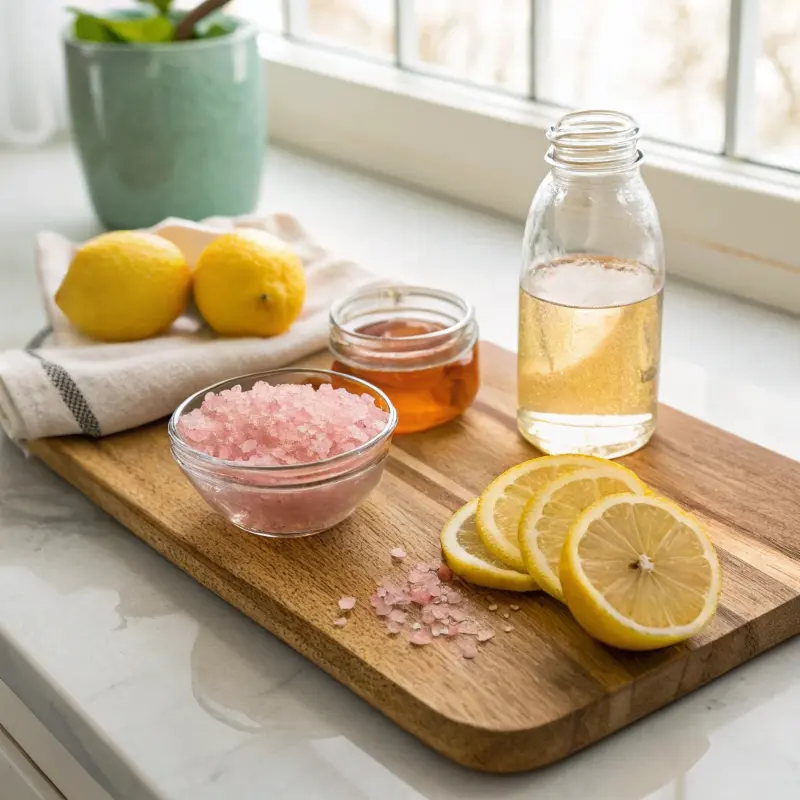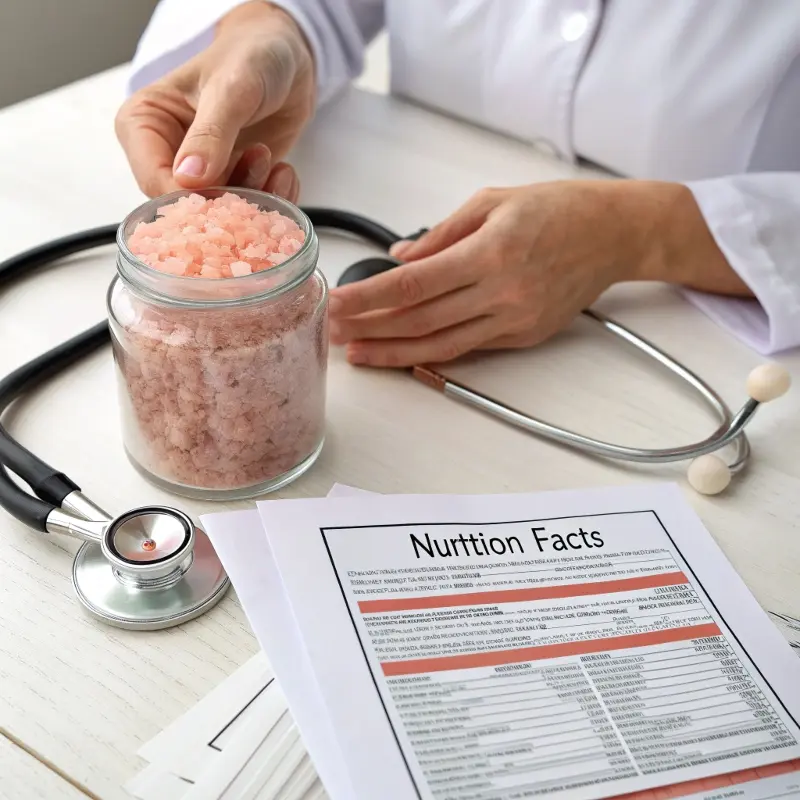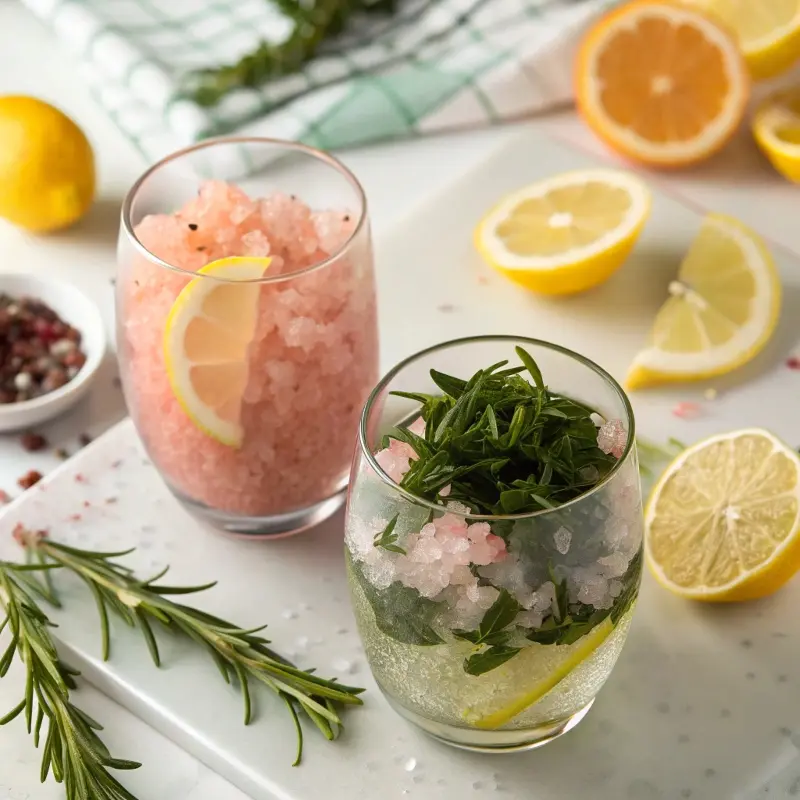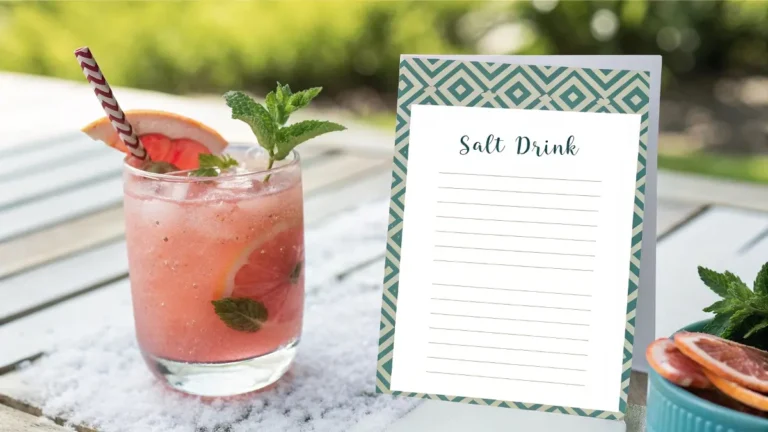If you spend any time on TikTok or wellness blogs, you’ve probably seen the hype: the Japanese pink salt diet recipe promises easy weight loss and all-day energy with just a glass of mineral water, lemon, and a pinch of pink salt. But as someone who grew up questioning every fad diet—especially after seeing loved ones disappointed by “miracle cures”—I wanted to know: is there real science behind the Japanese pink salt trick, or is it just another trending myth?
Table of Contents
According to a 2025 Statista report, nearly 28% of Americans have tried a trending diet hack in the past six months—yet more than 80% found the results underwhelming (Statista). My own kitchen experiments (and family debates!) with pink salt recipes taught me that most viral drinks sound better than they perform. That’s why this guide breaks down what’s really in the Japanese pink salt diet recipe, who should be careful, and which safe, science-backed alternatives might actually help.
What Is the Japanese Pink Salt Diet Recipe?
The Four-Ingredient Pink Salt Trend
The classic Japanese pink salt diet recipe is simple: just 1/4 teaspoon of Himalayan pink salt (sometimes Japanese sea salt), 1–2 cups filtered water, juice of half a lemon (or yuzu if you want to be truly on-trend), and a teaspoon of raw honey or maple syrup. Most influencers claim you should stir it all together and drink it first thing in the morning to “kickstart your metabolism” or “flush out toxins.”
Why “Japanese”? Is This Tradition or Trend?
Although the recipe borrows Japanese flavors (like yuzu), there’s little evidence this drink is rooted in Japanese tradition. It’s better described as a fusion of global wellness culture and viral marketing. True Japanese cuisine emphasizes mindful eating, seasonal ingredients, and balance—not miracle drinks. For more on authentic approaches, check our Japanese Pink Salt Recipe or this Pink Salt Recipe for Weight Loss for context.

Japanese Pink Salt Diet Recipe: Science or Wishful Thinking?
Is There Evidence for the Pink Salt Weight Loss Trick?
Scroll through any social feed and you’ll see bold promises about pink salt’s powers: faster metabolism, fat loss, even “detoxification.” But what does actual research say? To date, there are no clinical studies proving that Japanese pink salt or Himalayan pink salt water causes weight loss in healthy adults. While pink salt does contain trace minerals like magnesium and potassium, these are present in such tiny amounts that they don’t have a significant metabolic impact (NIH, 2023).
Most nutritionists agree: the real benefits of this recipe come from increased hydration—especially if you’re swapping soda or high-calorie drinks for mineral water with lemon. Staying hydrated can help you feel more satisfied, and proper water intake supports digestion and energy. But any “weight loss” is likely from eating better overall, not magic minerals.
Potential Risks: Who Should Avoid This Diet Trend?
Pink salt is often marketed as a healthier alternative to regular table salt, but it’s still sodium—too much can raise blood pressure and risk for heart disease, especially in people with hypertension or kidney issues (CDC). Anyone on a low-sodium diet or with a history of heart or kidney disease should skip the pink salt trend or consult a doctor first.
The honey or maple syrup in the recipe adds simple sugar, which might not be suitable for those watching blood sugar levels. As always, moderation matters—there’s no one-size-fits-all “miracle drink,” especially for weight loss.
If you want more details on mineral drinks that support a balanced diet, check our Himalayan Salt Electrolytes explainer or try a fresh option like this Brazilian Ginger Drink for an energy boost.

Healthy Alternatives and Safe Swaps for the Japanese Pink Salt Diet Recipe
Who Should Try an Alternative?
If you have high blood pressure, heart disease, kidney concerns, or simply want a lower-sodium routine, you should skip the pink salt drink—or use a safer substitute. Pink salt contains the same amount of sodium as regular salt, so anyone on a sodium-restricted diet must be extra cautious. People with diabetes or those watching their blood sugar might also want to avoid added honey or syrup.
For those looking for flavorful, mineral-rich drinks without extra salt, consider herbal infusions, water with lemon and cucumber, or even a splash of Brazilian Ginger Drink for a zesty lift. You’ll get hydration and a flavor boost without added sodium or sugar.
Sample Japanese Pink Salt Diet Recipe (and a Heart-Healthy Variation)
Here’s how the trending recipe is usually made, plus a simple swap that’s better for people sensitive to salt.
| Classic Pink Salt Drink | Low-Sodium Variation |
|---|---|
| 1/4 tsp Himalayan pink salt 1–2 cups filtered water Juice of 1/2 lemon or yuzu 1 tsp honey or maple syrup (optional) | Pinch dried seaweed (wakame or nori) 1–2 cups filtered water Juice of 1/2 lemon or orange Stevia or fresh mint (optional) |
| Directions: Mix all ingredients in a glass and stir until dissolved. For the variation, soak the seaweed in water for 5–10 minutes, add citrus juice and sweetener, and enjoy cold. | |
If you want more protein and energy for meal prep days, check our High Protein Egg Bites Meal Prep recipe, which pairs well with any healthy drink.

Japanese Pink Salt Diet Recipe FAQs & Science-Based Answers
What is the pink salt trick for weight loss recipe?
The viral “pink salt trick” is usually just 1/4 teaspoon of pink Himalayan salt dissolved in a large glass of water, often with lemon juice and sometimes honey. Influencers claim this drink “flushes out toxins” or “melts belly fat”—but scientific evidence doesn’t support these claims. Pink salt does offer trace minerals, but not in amounts that meaningfully impact metabolism. The real benefit is that you’re replacing soda or energy drinks with water, which supports hydration and can aid appetite control.
What is the pink salt weight loss formula?
Some blogs market the “formula” as a magic ratio of salt, lemon, and honey, but there’s no proven equation for weight loss. The healthiest use: a pinch of pink salt in water with lemon for taste, consumed in moderation as part of a balanced diet. Too much salt—pink or otherwise—raises blood pressure risk, so stick to recommended sodium limits.
What is the 4 ingredient pink salt trick?
The four-ingredient version is pink salt, water, lemon (or yuzu), and honey. Each adds flavor, but none have been proven to promote fat loss on their own. If you want a satisfying wellness ritual, try swapping honey for sliced cucumber or fresh mint to keep sugar and sodium low.
Does the pink salt trick actually work?
No, not for direct fat burning or rapid weight loss. Swapping calorie-dense drinks for mineral water with pink salt may help you cut calories and feel fuller, which can support healthy weight management—but there is no “trick” that replaces long-term habits. If you’re concerned about sodium intake, choose a variation like the seaweed-citrus water from Section 3 or simply stick with lemon water.
Are there risks to using pink salt recipes daily?
Too much pink salt can be just as harmful as too much regular salt. High sodium intake increases the risk of hypertension and cardiovascular disease. If you have a health condition or take medication, check with your doctor before changing your diet. Read our full pink salt recipe for weight loss guide for more safety info.

Conclusion: The Truth About the Japanese Pink Salt Diet Recipe
The Japanese pink salt diet recipe is a viral trend with more myth than science behind it. Pink salt water can be a tasty way to hydrate if you’re bored with plain water, but it’s not a shortcut for weight loss. For most Americans, focusing on overall balanced nutrition, regular movement, and evidence-based habits offers much more value—and fewer risks—than chasing every new “miracle drink.”
If you found this guide helpful, explore more science-backed wellness recipes at Healthy American Bites or drop your questions in the comments below. Stay curious, stay informed, and always put your health first!
Print
Japanese Pink Salt Diet Recipe: The Trend, The Facts, and Safe Alternatives
A Japanese-inspired pink salt drink made with Himalayan pink salt, lemon or yuzu, and honey. Enjoy as a refreshing, mineral-rich hydration ritual—always in moderation.
- Total Time: 2 minutes
- Yield: 1 serving
Ingredients
1/4 teaspoon pink Himalayan salt (or Japanese sea salt)
1–2 cups filtered water
Juice of 1/2 lemon (or 1 small yuzu, if available)
1 teaspoon raw honey (optional)
Instructions
1. Add pink salt to a glass.
2. Squeeze in lemon or yuzu juice, straining out seeds.
3. Pour in filtered water and stir well.
4. Mix in honey if using, and stir to dissolve.
5. Enjoy immediately, preferably before breakfast.
Notes
This recipe is not a substitute for professional medical advice.
Not recommended for those on a low-sodium diet or with kidney, heart, or blood pressure concerns.
Try seaweed-citrus water or plain lemon water as a lower-sodium alternative.
- Prep Time: 2 minutes
- Cook Time: 0 minutes
- Category: Wellness Drinks
- Method: No-Cook
- Cuisine: Japanese-Inspired
Disclaimer: This article is for informational purposes only and does not constitute medical advice. Always consult your healthcare provider before making dietary changes.

